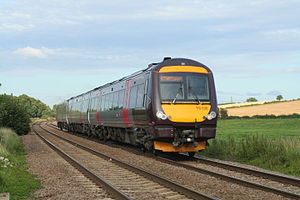| Bombardier Turbostar | |
|---|---|
 Class 170 in CrossCountry livery, westbound towards Leicester | |
| In service | 1998–present |
| Manufacturer |
|
| Built at | Derby Litchurch Lane Works |
| Constructed | 1997–2011 |
| Number built | 206 sets |
| Formation | 2, 3 or 4 carriages per set |
| Capacity | Varies depending on number of cars and seating configuration, see individual articles for details |
| Operators | |
| Specifications | |
| Car length | 23.62 m (77 ft 6 in) |
| Width | 2.69 m (8 ft 10 in) |
| Height | 3.77 m (12 ft 4 in) |
| Maximum speed | 100 mph (160 km/h) |
| Weight | Varies depending on number of cars and seating configuration, see individual articles for details |
| Traction system | Hydraulic transmission (168/170/171) Mechanical transmission (172) |
| Prime mover(s) | MTU 6R 183TD13H (168/170/171) MTU 6H1800R83 (172) |
| Safety system(s) | Various combinations of ATP, AWS, TPWS, Tripcock system |
| Coupling system | BSI[1]/Dellner couplers (Class 171, see below) |
| Track gauge | 1,435 mm (4 ft 8+1⁄2 in) standard gauge |
The Bombardier Turbostar (sold as the ADtranz Turbostar until 2001) is a family of diesel multiple unit (DMU) passenger trains that was built by ADtranz and later Bombardier Transportation at Derby Litchurch Lane Works in the United Kingdom between 1997 and 2011. The Turbostar was the first new train type to be introduced after the privatisation of British Rail. The first units were ordered by Chiltern Railways in 1996 and were designated Class 168 (also known as Clubman). Since then the family has grown with the addition of the Class 170, Class 171, and the Class 172.
- ^ "System Data for Mechanical and Electrical Coupling of Rail Vehicles". Rail Safety and Standards Board. Archived from the original on 5 July 2008. Retrieved 5 January 2009.